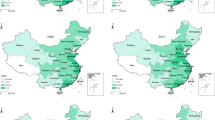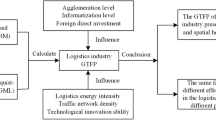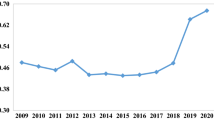Abstract
This paper aims to analyze the green efficiency performance of the logistics industry in China’s 30 provinces from 2008 to 2017. We first evaluate the green efficiency of the logistics industry through the non-directional distance function method. Then, we use the functional clustering method funHDDC, which is one of the popular machine learning methods, to divide 30 provinces into 4 clusters and analyze the similarities and differences in green efficiency performance patterns among different groups. Further, we explore the driving factors of dynamic changes in green efficiency through the decomposition method. The main conclusions of this paper are as follows: (1) in general, the level of green efficiency is closely related to the geographical location. From the clustering results, we can find that most of the eastern regions belong to the cluster with higher green efficiency, while most of the western regions belong to the cluster with lower green efficiency. However, the green efficiency performance in several regions with high economic levels, such as Beijing and Shanghai, is not satisfactory. (2) Based on the analysis of decomposition results, the innovation effect of China’s logistics industry is the most obvious, but the efficiency change still needs to be improved, and technical leadership should be strengthened. Based on these conclusions, we further propose some policy recommendations for the green development of the logistics industry in China.










Similar content being viewed by others
References
Ahmed, W., Najmi, A., & Khan, F. (2019). Examining the impact of institutional pressures and green supply chain management practices on firm performance. Management of Environmental Quality. https://doi.org/10.1108/MEQ-06-2019-0115.
Aldakhil, A. M., Nassani, A. A., Awan, U., Abro, M. M. Q., & Zaman, K. (2018). Determinants of green logistics in BRICS countries: An integrated supply chain model for green business. Journal of Cleaner Production, 195, 861–868.
Ameknassi, L., Aït-Kadi, D., & Rezg, N. (2016). Integration of logistics outsourcing decisions in a green supply chain design: A stochastic multi-objective multi-period multi-product programming model. International Journal of Production Economics, 182, 165–184.
Bagheri, M., Guevara, Z., Alikarami, M., Kennedy, C. A., & Doluweera, G. (2018). Green growth planning: A multi-factor energy input-output analysis of the Canadian economy. Energy Economics., 74, 708–720.
Berry, S., Davidson, K., & Saman, W. (2013). The impact of niche green developments in transforming the building sector: The case study of Lochiel Park. Energy Policy, 62, 646–655.
Bouveyron, C., Côme, E., & Jacques, J. (2015). The discriminative functional mixture model for a comparative analysis of bike sharing systems. The Annals of Applied Statistics., 9(4), 1726–1760.
Bouveyron, C., Girard, S., & Schmid, C. (2007). High dimensional data clustering. Computational Stats & Data Analysis, 52, 502–519.
Bouveyron, C., & Jacques, J. (2011). Model-based clustering of time series in group-specific functional subspaces. Advances in Data Analysis and Classification, 5, 281–300.
Cattell, R. B. (1966). The scree test for the number of factors. Multivariate Behavioral Research, 1(2), 245–276.
Celeux, G., & Govaert, G. (1995). Gaussian parsimonious clustering models. Pattern Recognition, 28(5), 781–793.
Chen, D., Ignatius, J., Sun, D., Zhan, S., Zhou, C., Marra, M., et al. (2019). Reverse logistics pricing strategy for a green supply chain: A view of customers’ environmental awareness. International Journal of Production Economics, 217, 197–210.
Chhabra, D., Garg, S. K., & Singh, R. K. (2017). Analyzing alternatives for green logistics in an Indian automotive organization: A case study. Journal of Cleaner Production, 167, 962–969.
Chung, Y. H., Färe, R., & Grosskopf, S. (1997). Productivity and undesirable outputs: A directional distance function approach. Journal of Environmental Management, 51(3), 229–240.
Dai, Y., & Gao, H. O. (2016). Energy consumption in China’s logistics industry: A decomposition analysis using the LMDI approach. Transportation Research Part D: Transport and Environment., 46, 69–80.
Davarzani, H., Fahimnia, B., Bell, M., & Sarkis, J. (2016). Greening ports and maritime logistics: A review. Transportation Research Part D, 48, 473–487.
Dekker, R., Bloemhof, J., & Mallidis, I. (2012). Operations Research for green logistics—An overview of aspects, issues, contributions and challenges. European Journal of Operational Research, 219, 671–679.
Demir, E., Hrušovský, M., Jammernegg, W., & Van Woensel, T. (2019). Green intermodal freight transportation: Bi-objective modelling and analysis. International Journal of Production Research, 57(19), 6162–6180.
Dev, N. K., Shankar, R., & Swami, S. (2020). Diffusion of green products in industry 4.0: Reverse logistics issues during design of inventory and production planning system. International Journal of Production Economics, 223, 107519.
Färe, R., Grosskopf, S., Lovell, C. K., & Pasurka, C. (1989). Multilateral productivity comparisons when some outputs are undesirable: A nonparametric approach. The Review of Economics and Statistics, 71, 90–98.
Firdausiyah, N., Taniguchi, E., & Qureshi, A. G. (2019). Modeling city logistics using adaptive dynamic programming based multi-agent simulation. Transportation Research Part E, 125, 74–96.
Garza-Reyes, J. A., Villarreal, B., Kumar, V., & Ruiz, P. M. (2016). Lean and green in the transport and logistics sector—A case study of simultaneous deployment. Production Planning & Control., 27(15), 1221–1232.
Goswami, M., De, A., Habibi, M. K. K., & Daultani, Y. (2020). Examining freight performance of third-party logistics providers within the automotive industry in India: an environmental sustainability perspective. International Journal of Production Research. https://doi.org/10.1080/00207543.2020.1756504.
Graham, S., Graham, B., & Holt, D. (2018). The relationship between downstream environmental logistics practices and performance. International Journal of Production Economics, 196, 356–365.
Gu, W., Wei, L., Zhang, W., & Yan, X. (2019). Evolutionary game analysis of cooperation between natural resource- and energy-intensive companies in reverse logistics operations. International Journal of Production Economics, 218, 159–169.
Hartigan, J. A., & Wong, M. A. (1979). Algorithm AS 136: A k-means clustering algorithm. Applied Statistics, 28(1), 100–108.
Hong, J., Alzaman, C., Diabat, A., & Bulgak, A. (2019). Sustainability dimensions and PM2.5 in supply chain logistics. Annals of Operations Research, 275, 339–366.
Hou, D., Li, G., Chen, D., Zhu, B., & Hu, S. (2019). Evaluation and analysis on the green development of China’s industrial parks using the long-tail effect model. Journal of Environmental Management, 248, 109288.
IPCC. (2006). Guidelines for National Greenhouse Gas Inventories. Intergovernmental Panel on Climate Change. Retrieved December 2019, from https://www.ipcc-nggip.iges.or.jp/public/2006gl/index.html.
Jacques, J., & Preda, C. (2014). Functional data clustering: A survey. Advances in Data Analysis and Classification, 8(3), 231–255.
James, G. M., & Sugar, C. A. (2003). Clustering for sparsely sampled functional data. Journal of the American Statistical Association., 98(462), 397–408.
Ji, S. F., Luo, R. J., & Peng, X. S. (2019). A probability guided evolutionary algorithm for multi-objective green express cabinet assignment in urban last-mile logistics. International Journal of Production Research, 57(11), 3382–3404.
Jiahuey, Y., Liu, Y., & Yu, Y. (2019). Measuring green growth performance of China’s chemical industry. Resources, Conservation and Recycling, 149, 160–167.
Jin, P., Peng, C., & Song, M. (2019). Macroeconomic uncertainty, high-level innovation, and urban green development performance in China. China Economic Review, 55, 1–18.
Khor, K. S., & Udin, Z. M. (2013). Reverse logistics in Malaysia: Investigating the effect of green product design and resource commitment. Resources, Conservation and Recycling, 81, 71–80.
Kuo, T. C., Chiu, M. C., Chung, W. H., & Yang, T. I. (2019). The circular economy of LCD panel shipping in a packaging logistics system. Resources, Conservation and Recycling, 149, 435–444.
Leroy, A., Marc, A., Dupas, O., Rey, J. L., & Gey, S. (2018). Functional data analysis in sport science: Example of swimmers’ progression curves clustering. Applied Sciences., 8(10), 1766.
Li, A., Chen, Y., & Wang, D. (2020). An empirical study of the factors influencing the willingness to implement green coal logistics in China. Journal of Cleaner Production, 245, 118932.
Li, W., Wang, J., Chen, R., Xi, Y., Liu, S. Q., Wu, F., et al. (2019). Innovation-driven industrial green development: The moderating role of regional factors. Journal of Cleaner Production, 222, 344–354.
Lin, B., & Du, K. (2015). Energy and CO2 emissions performance in China’s regional economies: Do market-oriented reforms matter? Energy Policy, 78, 113–124.
Lin, B., & Wu, R. (2020). Designing energy policy based on dynamic change in energy and carbon dioxide emission performance of China’s iron and steel industry. Journal of Cleaner Production, 256, 120412.
Lin, B., & Zhu, J. (2019a). Impact of energy saving and emission reduction policy on urban sustainable development: Empirical evidence from China. Applied Energy, 239, 12–22.
Lin, B., & Zhu, J. (2019b). Fiscal spending and green economic growth: Evidence from China. Energy Economics, 83, 264–271.
Marinakis, Y., Marinaki, M., Doumpos, M., Matsatsinis, N., & Zopounidis, C. (2011). A hybrid ACO-GRASP algorithm for clustering analysis. Annals of Operations Research, 188, 343–358.
Martínez-Álvarez, F., Schmutz, A., Asencio-Cortés, G., & Jacques, J. (2019). A novel hybrid algorithm to forecast functional time series based on pattern sequence similarity with application to electricity demand. Energies, 12(1), 94.
Melkonyan, A., Gruchmann, T., Lohmar, F., Kamath, V., & Spinler, S. (2020). Sustainability assessment of last-mile logistics and distribution strategies: The case of local food networks. International Journal of Production Economics, 228, 107746.
Oberhofer, P., & Dieplinger, M. (2013). Sustainability in the transport and logistics sector: Lacking environmental measures. Business Strategy and the Environment, 23(4), 236–253.
Rajabi, A., Eskandari, M., Ghadi, M. J., Li, L., Zhang, J., & Siano, P. (2020). A comparative study of clustering techniques for electrical load pattern segmentation. Renewable and Sustainable Energy Reviews, 120, 109628.
Rashidi, K., & Cullinane, K. (2019). Evaluating the sustainability of national logistics performance using data envelopment analysis. Transport Policy, 74, 35–46.
Sbihi, A., & Eglese, R. W. (2010). Combinatorial optimization and Green Logistics. Annals of Operations Research, 175, 159–175.
Shao, S., Xu, G., Li, M., & Huang, G. Q. (2019). Synchronizing e-commerce city logistics with sliding time windows. Transportation Research Part E, 123, 17–28.
Shen, Z., Baležentis, T., Chen, X., & Valdmanis, V. (2018). Green growth and structural change in Chinese agricultural sector during 1997–2014. China Economic Review, 51, 83–96.
Sureeyatanapas, P., Poophiukhok, P., & Pathumnakul, S. (2018). Green initiatives for logistics service providers: An investigation of antecedent factors and the contributions to corporate goals. Journal of Cleaner Production, 191, 1–14.
Suzanne, E., Absi, N., & Borodin, V. (2020). Towards circular economy in production planning: Challenges and opportunities. European Journal of Operational Research, 287, 168–190.
Tang, S., Wang, W., Yan, H., & Hao, G. (2015). Low carbon logistics: Reducing shipment frequency to cut carbon emissions. International Journal of Production Economics, 164, 339–350.
Tipping, M. E., & Bishop, C. M. (1999). Mixtures of probabilistic principal component analyzers. Neural Computation, 11(2), 443–482.
Yang, J., Tang, L., Mi, Z., Liu, S., Li, L., & Zheng, J. (2019). Carbon emissions performance in logistics at the city level. Journal of Cleaner Production, 231, 1258–1266.
Yao, X., Cheng, Y., & Song, M. (2019). Assessment of collaboration in city logistics: From the aspects of profit and CO2 emissions. International Journal of Logistics Research and Applications., 22(6), 576–591.
Yi, H., & Liu, Y. (2015). Green economy in China: Regional variations and policy drivers. Global Environmental Change, 31, 11–19.
Yuan, B. L., & Xiang, Q. L. (2018). Environmental regulation, industrial innovation and green development of Chinese manufacturing: Based on an extended CDM model. Journal of Cleaner Production, 176, 895–908.
Zarbakhshnia, N., Soleimani, H., Goh, M., & Razavi, S. S. (2019). A novel multi-objective model for green forward and reverse logistics network design. Journal of Cleaner Production, 208, 1304–1316.
Zhang, Y., Alshraideh, H., & Diabat, A. (2018). A stochastic reverse logistics production routing model with environmental considerations. Annals of Operations Research, 271, 1023–1044.
Zhang, N., & Choi, Y. (2013). Total-factor carbon emission performance of fossil fuel power plants in China: A metafrontier non-radial Malmquist index analysis. Energy Economics, 40, 549–559.
Zhang, N., & Choi, Y. (2014). A note on the evolution of directional distance function and its development in energy and environmental studies 1997-2013. Renewable and Sustainable Energy Reviews, 33, 50–59.
Zhou, P., Ang, B. W., & Wang, H. (2012). Energy and CO2 emission performance in electricity generation: a non-radial directional distance function approach. European Journal of Operational Research, 221(3), 625–635.
Zhou, Y., Liu, W., Lv, X., Chen, X., & Shen, M. (2019). Investigating interior driving factors and cross-industrial linkages of carbon emission efficiency in China’s construction industry: Based on super-SBM DEA and GVAR model. Journal of Cleaner Production, 241, 118322.
Zhu, B., Zhang, M., Huang, L., Wang, P., Su, B., & Wei, Y. M. (2020). Exploring the effect of carbon trading mechanism on China’s green development efficiency: A novel integrated approach. Energy Economics, 85, 104601.
Acknowledgements
This work was supported by the National Natural Science Foundation of China (Grant Numbers 71874149, 71934001, 71471001, 41771568, 71533004); the National Social Science Fund of China (Grant Number 20ZDA084); and the National Key Research and Development Program of China (Grant Number 2016YFA0602500).
Author information
Authors and Affiliations
Corresponding author
Ethics declarations
Conflict of interest
None.
Additional information
Publisher's Note
Springer Nature remains neutral with regard to jurisdictional claims in published maps and institutional affiliations.
Rights and permissions
About this article
Cite this article
Yao, X., Cheng, Y., Zhou, L. et al. Green efficiency performance analysis of the logistics industry in China: based on a kind of machine learning methods. Ann Oper Res 308, 727–752 (2022). https://doi.org/10.1007/s10479-020-03763-w
Published:
Issue Date:
DOI: https://doi.org/10.1007/s10479-020-03763-w




